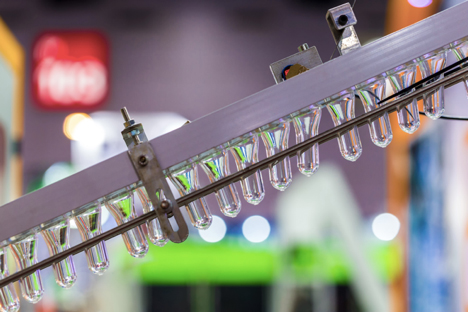
Polyethylene terephthalate (PET) plastic is a durable, lightweight plastic often used to make containers for the food and beverage, pharmaceutical and personal care industries. A version of polyester plastic has been around since 1833 when they it was first developed as a liquid varnish. In 1941, PET was developed by chemists at DuPont, but it took until the 1970s for the plastic bottle to be popularized.
An engineer for the DuPont Corporation, Nathaniel C. Wyeth, developed the first plastic bottle after years of experimenting. He discovered the blow-molding method still in use today. Wyeth conquered long-running problems — such as uneven wall thickness and irregular neck sizes — with blow-molding plastics, and solidified a process that creates a well-structured, durable plastic bottle.
Since then, billions of bottles are being manufactured each year, leading to an increase in community recycling programs around the United States to curb landfill growth and increase re-use of the material. Manufacturers are now finding new ways to recycle PET and put it to good use in the marketplace.
The Makings of Plastic Bottles
PET is a form of polyester. It is a polymer primarily derived from petroleum hydrocarbons and is the result of a reaction between monomers ethylene glycol and terephthalic acid.
In the making of PET plastics, terephthalic acid is combined with Methanol to produce Dimethyl Terephthalate and water. This product is then combined with Ethylene Glycol at a temperature of 305 degrees Fahrenheit to create another substance, known as Bis(2-hydroxethyl) terephthalate and methanol.
In the final step, a polymer is formed while another molecule is released. This condensation polymerization process of the Bis(2-hydroxethyl) Terephthalate occurs in a vacuum at 530 degrees Fahrenheit, producing chains of PET and ethylene glycol, which is constantly removed during the polymerization process and used to make additional PET.
When the PET mixture reaches the right thickness, it is quickly cooled to prevent discoloration and degradation. It can later be reheated for additional uses.
The Bottle-Making Process
PET bottles are typically created using one of the three blow molding processes listed below.
Injection Blow Moulding
Ideal for smaller plastic bottles, the Injection Blow Moulding process can be used to mould a wide variety of polymers including PET and HDPE. Break down the steps and see one way plastic goes from pellet to container in this short video.
Extrusion Blow Moulding
The Extrusion Blow Moulding process involves extruding a melted plastic polymer, typically HDPE or LDPE into a hollow tube or “Parison”. During the Extrusion Shuttle Blow Moulding process two moulds shuttle back and forth to capture a continuously extruded parison. Learn how in this short video.
Injection Stretch Blow Moulding Process
A wide variety of bottles, jars, and other containers can be moulded using the versatile Injection Stretch Blow Moulding Process. Preforms can be immediately molded into final containers via the 1-Step method, or saved as stock for later use in the 2-Step method. We’ll break down the 1-Step process from pellet to container in this quick video.
The Inspection Process
Rigorous testing is performed on PET bottles as the last step in the manufacturing line before packing, ensuring they meet industry standards. Testing can include:
- Impact-resistance testing
- Pressure testing
- Permeability testing
- Transparency inspection
Manufacturers also test to ensure there is consistency in the size, shape, and finish of the end product before packaging and shipping to the final destination.







































